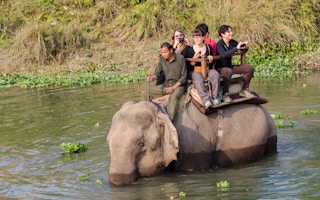Wild male elephants in search of females to mate with are homing in on captive domestic elephants, in the process posing a threat to human settlements and property on the outskirts of Nepal’s Chitwan National Park.
Wild bulls are involved in around one incident of property damage every month, according to the Chitwan National Park Buffer Zone Council, and cases in which humans are injured by wild elephants are also on the rise.
Some activists have long advocated for domesticated elephants to be cared for in sanctuary-type centres, where they can roam freely and get adequate care, rather than in the pens and stables where private owners typically house them. However, government officials say they don’t have the resources or the land to establish such centres, and that the onus is on private elephant owners to take appropriate measures themselves to prevent conflict situations.
A totem to these conflicts is the concrete elephant statue that stands outside the biodiversity conservation centre in the town of Sauraha, the main gateway to Chitwan National Park. A favourite photo stop for visitors, the statue has been attacked several times by a resident wild elephant bull of the Chitwan-Parsa complex, known to local officials as Ronaldo (who is not a goat), who charges at it regularly for perceived territorial violations.
“
They have been confined to small spaces and don’t get adequate care. Now, they are being considered security threats because of the wild male bulls they attract.
Shristi Singh Shrestha, activist, Animal Nepal
“Bulls such as Ronaldo, which are expelled by the matriarch of their group during the ‘teenage’ phase for being unruly, now pose a threat to the safety of local people and property,” says Birendra Mahato, director at the Tharu Cultural Museum and Research Center in Chitwan.
Unattached young males like Ronaldo, amped up with raging hormones, move in and out of human settlements, home to 97 domesticated elephants, that lie within 3-4 kilometres (1.8-2.5 miles) of the national park. For these elephants, mating success is far greater with domesticated female elephants than trying their luck with a female in the wild. In the process of trying to reach them, however, “anyone or anything that comes in the way is removed,” Mahato says.
Sauraha has seen a rapid expansion in human settlements recent decades, in large part thanks to the park’s conservation successes with elephants, tigers and rhinos, which in turn have fueled the area’s tourism boom. In the past, domesticated elephants had ample space to roam around as human settlements were sparse. But with more tourists arriving, including from around the world, settlements have expanded to cater to the industry, and the domesticated elephants have become confined to small areas, often near human settlements. And the wild bulls follow the domesticated females wherever they go, regardless of their proximity to human settlements.
On Jan. 29 this year, four people were injured when a wild elephant, known as Gobinde, attacked them close to a stable holding domesticated elephants in the Kumroj area.
Incidents like this compound the already severe problem of human-elephant conflict in Nepal. As their habitats are fragmented and their traditional migration routes obstructed, elephants are increasingly pushed into closer and more frequent encounters with humans, who in turn blame them for destroying their crops and damaging their property.
“It’s like a ticking time bomb that can explode any time,” said a resident of Sauraha, who asked not to be identified. “No one is doing anything about addressing the problem until a big incident happens.”
Elephant welfare activists have long been demanding a safer environment for domesticated elephants in Chitwan. After years of campaigning, their work has resulted in far fewer tourists opting to go on elephant rides. This long-running practice has been shown to cause long-term physical damage to the animals. “However, that hasn’t ended the misery for them,” says activist Shristi Singh Shrestha. “They have been confined to small spaces and don’t get adequate care. Now, they are being considered security threats because of the wild male bulls they attract.”
Shrestha has long campaigned on the need for a sanctuary for domesticated elephants. Under such a model, the elephants would get to roam freely in a specific area where they would also be treated more humanely. “If we have a sanctuary for domesticated elephants, the security threat could also be minimised,” she added.
The model would also resolve issues that arose during the Covid-19 pandemic. With the tourism industry shut down, elephant owners no longer had the income to feed themselves, let alone their elephants. Some even tried selling their elephants across the border in India, illegally. Others demanded that the government allow them to graze their elephants inside the national park.
Mahato says he agrees on the need for a shared sanctuary for domesticated elephants. “Once that’s done, the scattered population of domesticated elephants can be concentrated in one place where people and their properties don’t come in between the bulls and the cows,” he adds. “This can help avert accidents and escalation of human-elephant conflict in the future.”
But officials say there’s neither room nor resources for such a sanctuary. Maheshwar Dhakal, director-general of the Department of National Parks and Wildlife Conservation, said the private elephant owners need to take their own appropriate measures to care for their animals safely. “The animals are their private property and there’s very little that the government can do about it,” he says.
This story was published with permission from Mongabay.com.

















